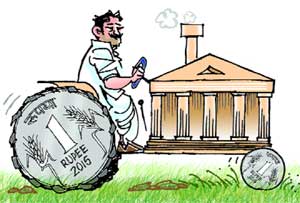The ability to smooth consumption is critical for the poor even from a survival point of view. Mainstream economics research has shown that a significant part of the hardships faced by the poor can be avoided if they can save gains made during good times and borrow at reasonable rates during bad times. Lack of access to formal credit as well as safe savings instruments has been a stumbling block for Indian poor to engage in consumption smoothing and tide over difficult times. It is heartening to note that the situation has changed significantly over the last one year with the launch of the Pradhan Mantri Jan-Dhan Yojana. Almost all rural poor in India now have access to safe saving instrument and are in the process of getting access to credit.
It is well known to economists that consumers generally consume only that part of the income which they consider as relatively permanent and save a large part of transitory income. This is known as the permanent income hypothesis (PIH). A number of studies have found empirical evidence consistent with the PIH.
For example, a research study published in the American Economic Review by Christina H Paxson uses weather variability in Thailand to study the response of savings to transitory income. They find that farmers save the “excess” income realised during good weather years and use the same to support consumption during years when the rainfall is deficient. On similar lines, a Journal of Political Economy article authored by DW Wilcox studies consumption behaviour of Indian farmers and finds similar results.
However, as argued by T Jappelli and L Pistaferri, lack of access to formal sources of finance leads to failure of the PIH in many cases. For example, in the Indian case, it has been shown—in a Journal of Political Economy article by MR Rosenzweig and KI Wolpin—that Indian farmers used bullocks to engage in consumption smoothing. In other words, Indian farmers, in the 1990s, used to buy bullocks during good times and sell them during bad times to maintain subsistence levels of consumption. Our own research (by Mrinal Mishra, Prasanna Tantri and Nagaraju Thota) points towards the fact that poor households in India also use jewellery and durables for consumption smoothing.
Definitely, this kind of consumption smoothing is inefficient. The farmer is giving up a productive asset and hence stifling the prospects of his own recovery. As well, given that such markets are likely to be opaque and inefficient, a farmer with low bargaining power is unlikely to receive fair value. Finally, liquidity is also likely to be fairly low in such markets, leading to deep discounts in case of distress sales.
The Jan-Dhan Yojana has the potential to be a game-changer in this regard. It has already provided the poor households with access to safe and liquid saving instrument. The process of granting loans to Jan-Dhan account holders has also begun. Within a matter of 14 months, the progress made is staggering—according to figures given in the Jan-Dhan Yojana website, 18.47 crore accounts have been opened and the amount of money deposited in those accounts has crossed Rs 24,000 crore. The most heartening aspect is the dramatic fall in the proportion of zero balance accounts—the proportion has fallen from 0.76 in September 2014 to 0.44 in August 2015. This translates to an average balance of approximately Rs 2,350 for every active account.
The Jan-Dhan Yojana represents a paradigm shift in the approach adopted by the government towards solving the financial inclusion problem. Most previous attempts such as loan waivers, loan melas, etc, were primarily designed as doles in return for political support. Our own research as well as research done by World Bank economists has clearly shown that such schemes have had a negative impact on the borrowing culture. The Jan-Dhan Yojana, on the other hand, nudges the households towards inculcating sound banking habits.
One of the striking features of the programme is the design of the overdraft facility. It is well known to financial economists that having a well-performing savings account gives comfort to the loan officer while granting loans. Just imagine a loan officer who is newly posted to a village and is faced with the task of processing loan applications. In the case of new borrowers (not having a bank account hitherto), there is no way a the loan officer is likely to be able to assess the credit worthiness. Enforcing collateral is a Herculean task for banks given the political sensitivity of such measures. Therefore, rejecting such loan applications turns out to be the best strategy from the loan officer’s point of view. Now imagine a situation where the borrowers have a track-record generated through savings account transactions. The loan officer, in this case, is likely to feel far more comfortable in lending to those who show financial discipline in savings pattern.
Once the above information percolates down to the household level, it is possible that the households will understand that sound banking habits are likely to be rewarded. Contrast this with a debt waiver for defaulting farmers. The programme punished severely those farmers who were financially-disciplined and made them appear like fools. This could have generated a sense of regret among such farmers.
There is no doubt that the Jan-Dhan Yojana is one the most fundamental reforms undertaken in the recent past. The success of the programme looks even more stunning when we consider the fact that last two years have been near-drought years. Based on the findings of rigorous academic research, it is reasonable to predict that the scheme is going to help households smooth consumption and hence overcome a lot of hardships faced during difficult times.
The author works as a senior associate director with the Center For Analytical Finance, Indian School of Business
